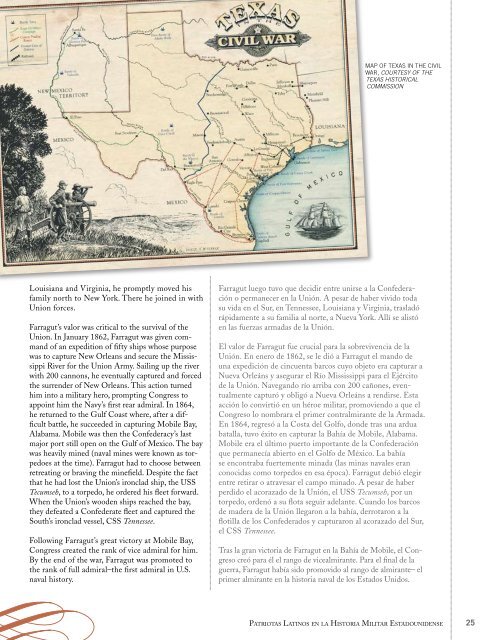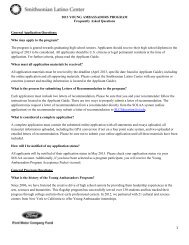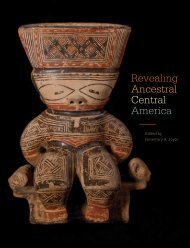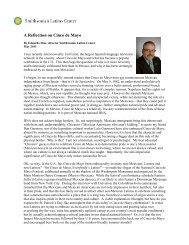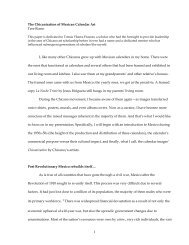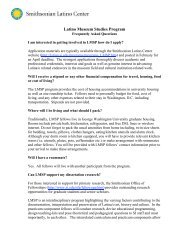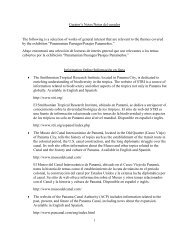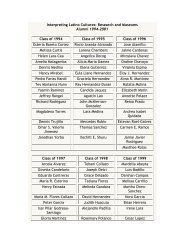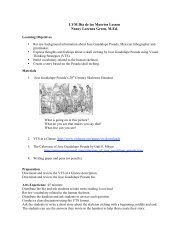(1861–1865) la Guerra Civil - Smithsonian Latino Center ...
(1861–1865) la Guerra Civil - Smithsonian Latino Center ...
(1861–1865) la Guerra Civil - Smithsonian Latino Center ...
Create successful ePaper yourself
Turn your PDF publications into a flip-book with our unique Google optimized e-Paper software.
Map of Texas in the <strong>Civil</strong><br />
War, Courtesy of the<br />
Texas Historical<br />
Commission<br />
Louisiana and Virginia, he promptly moved his<br />
family north to New York. There he joined in with<br />
Union forces.<br />
Farragut’s valor was critical to the survival of the<br />
Union. In January 1862, Farragut was given command<br />
of an expedition of fifty ships whose purpose<br />
was to capture New Orleans and secure the Mississippi<br />
River for the Union Army. Sailing up the river<br />
with 200 cannons, he eventually captured and forced<br />
the surrender of New Orleans. This action turned<br />
him into a military hero, prompting Congress to<br />
appoint him the Navy’s first rear admiral. In 1864,<br />
he returned to the Gulf Coast where, after a difficult<br />
battle, he succeeded in capturing Mobile Bay,<br />
A<strong>la</strong>bama. Mobile was then the Confederacy’s <strong>la</strong>st<br />
major port still open on the Gulf of Mexico. The bay<br />
was heavily mined (naval mines were known as torpedoes<br />
at the time). Farragut had to choose between<br />
retreating or braving the minefield. Despite the fact<br />
that he had lost the Union’s ironc<strong>la</strong>d ship, the USS<br />
Tecumseh, to a torpedo, he ordered his fleet forward.<br />
When the Union’s wooden ships reached the bay,<br />
they defeated a Confederate fleet and captured the<br />
South’s ironc<strong>la</strong>d vessel, CSS Tennessee.<br />
Following Farragut’s great victory at Mobile Bay,<br />
Congress created the rank of vice admiral for him.<br />
By the end of the war, Farragut was promoted to<br />
the rank of full admiral–the first admiral in U.S.<br />
naval history.<br />
Farragut luego tuvo que decidir entre unirse a <strong>la</strong> Confederación<br />
o permanecer en <strong>la</strong> Unión. A pesar de haber vivido toda<br />
su vida en el Sur, en Tennessee, Louisiana y Virginia, tras<strong>la</strong>dó<br />
rápidamente a su familia al norte, a Nueva York. Allí se alistó<br />
en <strong>la</strong>s fuerzas armadas de <strong>la</strong> Unión.<br />
El valor de Farragut fue crucial para <strong>la</strong> sobrevivencia de <strong>la</strong><br />
Unión. En enero de 1862, se le dió a Farragut el mando de<br />
una expedición de cincuenta barcos cuyo objeto era capturar a<br />
Nueva Orleáns y asegurar el Río Mississippi para el Ejército<br />
de <strong>la</strong> Unión. Navegando río arriba con 200 cañones, eventualmente<br />
capturó y obligó a Nueva Orleáns a rendirse. Esta<br />
acción lo convirtió en un héroe militar, promoviendo a que el<br />
Congreso lo nombrara el primer contralmirante de <strong>la</strong> Armada.<br />
En 1864, regresó a <strong>la</strong> Costa del Golfo, donde tras una ardua<br />
batal<strong>la</strong>, tuvo éxito en capturar <strong>la</strong> Bahía de Mobile, A<strong>la</strong>bama.<br />
Mobile era el último puerto importante de <strong>la</strong> Confederación<br />
que permanecía abierto en el Golfo de México. La bahía<br />
se encontraba fuertemente minada (<strong>la</strong>s minas navales eran<br />
conocidas como torpedos en esa época). Farragut debió elegir<br />
entre retirar o atravesar el campo minado. A pesar de haber<br />
perdido el acorazado de <strong>la</strong> Unión, el USS Tecumseh, por un<br />
torpedo, ordenó a su flota seguir ade<strong>la</strong>nte. Cuando los barcos<br />
de madera de <strong>la</strong> Unión llegaron a <strong>la</strong> bahía, derrotaron a <strong>la</strong><br />
flotil<strong>la</strong> de los Confederados y capturaron al acorazado del Sur,<br />
el CSS Tennessee.<br />
Tras <strong>la</strong> gran victoria de Farragut en <strong>la</strong> Bahía de Mobile, el Congreso<br />
creó para él el rango de vicealmirante. Para el final de <strong>la</strong><br />
guerra, Farragut había sido promovido al rango de almirante– el<br />
primer almirante en <strong>la</strong> historia naval de los Estados Unidos.<br />
25


